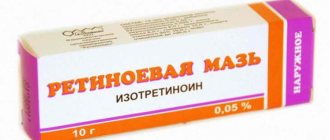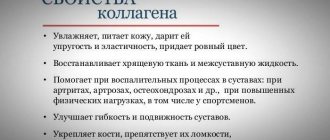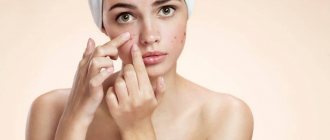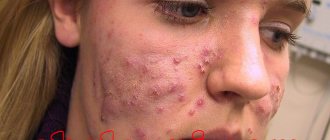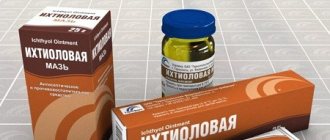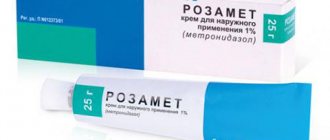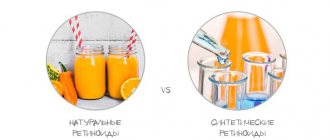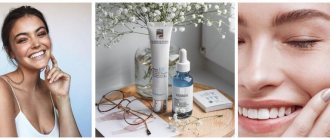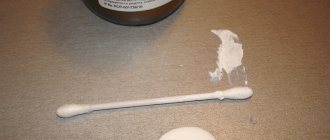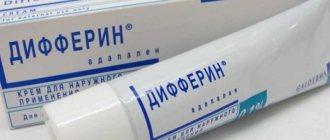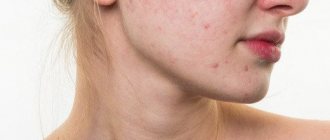Does Retinoic ointment help with acne and rosacea?
The appearance of acne can be caused by various factors:
- hormonal changes;
- prolonged stress;
- lack of adequate skin care;
- accompanying pathologies.
That is why, if acne occurs, you should contact a specialist to conduct an examination and prescribe the correct therapy, which will depend on the severity of the inflammatory process. The appearance of acne includes several stages:
- increased secretion of sebum;
- change in the keratinization process;
- activation of pathogenic microorganisms living on the skin;
- inflammatory process.
Attention! The effectiveness of Retinoic ointment is determined by its composition and mechanism of action. The product is used for severe acne.
Composition and release form
Retinoic ointment belongs to the group of retinoids. The main active ingredient is vitamin A, which is a fat-soluble vitamin.
Vitamin A is directly involved in products:
- lipids;
- proteins;
- mucopolysaccharides.
The vitamin also regulates the balance of minerals, allows differentiation of epithelial cells, and normalizes keratinization. Thanks to this component, regeneration of the skin and mucous membranes occurs.
Important! Keratinization is a natural process in which dead cellular elements are shed and sloughed off.
Vitamin A helps regulate the activity of the sebaceous glands. When consumed against the background of acne, a decrease in sebum production occurs. The substance has a positive effect on the production of immunoglobulin cells, the function of which is to protect the skin from harmful microorganisms.
The retinoid contained in the drug can be either natural or synthetic. The composition also includes auxiliary components that have antimicrobial and anti-inflammatory effects. Additional components of the drug include:
- antioxidant dibunol, which prevents damage to cellular elements by free radicals;
- ethyl alcohol, which has a bactericidal effect due to its disinfectant properties;
- glycerin, which helps moisturize the skin;
- butyloxyanisole, which prevents oxidation processes and maintains the stability of all components present in the preparation;
- Vaseline oil, which softens the skin and prevents it from drying out.
The medicine is applied to the skin to get rid of acne.
Useful properties of Retinoic ointment
Retinoic ointment is indicated for the following pathological skin conditions:
- open and closed comedones;
- seborrhea;
- various forms of acne (nodular cystic, papulopustular);
- Rosacea.
One of the indications for taking Retinoic ointment is acne and acne. The use of the drug prevents the appearance of new rashes and relieves post-acne.
The following properties of Retinoic ointment are called:
- anti-inflammatory;
- keratolytic, which manifests itself in the exfoliation of dead cellular elements of the epidermis;
- sebostatic, which implies normalization of the functioning of the sebaceous glands;
- regenerating.
Retinoic ointment eliminates acne due to the following factors:
- slowing down the growth of epithelial tissue;
- liquefaction of sebum;
- removal of dead particles from the surface of the skin;
- normalization of skin regeneration processes.
Retinoic ointment affects different layers of the skin. That is why treatment with the drug is also effective in the presence of subcutaneous acne. The drug can be used to treat not only facial skin.
Instructions for use of Retinoic acne ointment
According to the instructions, Retinoic ointment should be applied to clean skin twice a day in a thin layer.
How to use Retinoic ointment for acne
Retinoic ointment can be used for purulent and subcutaneous acne due to its effect on the superficial and deep layers of the skin. The product is applied to cleansed skin 1-2 times a day. Usually the course of treatment lasts from 1 to 3 months.
Attention! After a significant amount of acne disappears, you need to reduce the dosage of the drug from 0.1 to 0.05%. It is allowed to apply Retinoic ointment once for 3 days.
How to use Retinoic ointment for blackheads
Pores clogged with sebaceous plugs appear as blackheads. Reviews contain information that Retinoic ointment is effective against acne. This is due to the normalization of sebum production and its dilution. The minimum therapeutic course is 1 month. Retinoic ointment is applied to a cleansed face twice a day.
How to use Retinoic ointment for closed comedones
Retinoic ointment can be used for comedones. Regular use of the drug at least once every 3 days helps cleanse the skin.
Important! The drug allows you to get rid of not only pimples, blackheads and closed comedones. Retinoic ointment is actively prescribed to patients for scars and other skin defects.
Use of Retinoic ointment for rosacea
Against the background of rosacea, a vascular network appears on the face, which can have varying degrees of severity. Retinoic ointment is used for both acne and rosacea. The result of treatment is associated with the presence of vitamin A in the drug, which has a beneficial effect on the condition of the skin.
Retinoic ointment is applied to the face no more than 2 times a day. Treatment is carried out mainly in the autumn, winter and spring periods, which is associated with reduced solar activity.
Expert opinion
Dermatologists prescribe retinoic ointment as both a symptomatic treatment for identified diseases and as an independent treatment aimed at eliminating the consequences of serious rashes that lead to changes in skin texture. Experts note several main points underlying the evidence base for the action of the ointment:
- Colloidal scars become less noticeable by 30%.
- The formation of new acne is stopped completely.
- Subcutaneous acne disappears in most cases during the first course and in more than 95% of cases after three courses of use.
At the same time, the ointment performed mediocre against comedones. Sebaceous plugs that lie deep in the epidermis are not affected by retinoids and require a separate approach in the form of mechanical cleansing.
Precautionary measures
To avoid adverse effects of the drug on the skin, the following rules should be followed:
- single use of the drug before bedtime for the first use;
- preliminary cleansing of the skin with products that do not cause dryness;
- use once every 2 days if there is redness and a gradual transition to more frequent application.
When treating acne with Retinoic ointment, experts strongly advise following the following recommendations, which significantly affect the effectiveness of therapy:
- The drug may increase the sensitivity of the skin to sunlight. In this connection, it is advisable to carry out treatment in autumn-spring, as well as in winter. In sunny days, you need to use creams with SPF, predominantly of a high degree of protection.
- Retinoic ointment for facial acne should not be applied under the eyes or around the mouth.
- To avoid the appearance of peeling during treatment, it is advisable to simultaneously use a cream that prevents dry skin. Cosmetics must have a moisturizing effect.
- Facial cleansers should be as gentle as possible so as not to cause irritation.
- It is not recommended to discontinue the drug abruptly. The number of procedures should be reduced gradually, after which you can stop using the drug.
Usually, during the first days of treatment, you can notice an increase in the severity of acne and pimples, which is normal. These signs are short-lived. After a few weeks there is improvement.
Attention! The effectiveness of the drug can be assessed no earlier than after a month. Compliance with the necessary requirements specified in the instructions is essential.
Recommendations for skin care after treatment
Long after the end of the course, the skin requires increased measures to maintain water balance and protect against drying out. Therefore, you should use the same gentle creams and tonics as during the treatment period. Since care products for particularly sensitive skin are expensive, you can use the following tips:
- Every morning and evening, wipe your face with a cotton pad with a small amount of milk intended for treating baby skin.
- After carefully cleansing your skin, apply a few drops of pure almond oil to your fingertips and gently pat it into your face.
Only after these steps can you use decorative cosmetics if the procedure takes place in the evening or go to bed if everything happens before bed. A prerequisite is to wash off your makeup at night, otherwise the comedones will appear again.
Contraindications and side effects
Retinoic ointment is a medicine. Its use may be contraindicated in some cases:
- pregnancy and lactation period due to the penetration of the active substance into the systemic bloodstream and its subsequent accumulation in the body, which is fraught with the appearance of malformations;
- reproductive plans;
- hypervitaminosis A;
- impaired functioning of the kidneys and liver.
Ignoring contraindications may lead to adverse reactions. Typically, undesirable effects appear early in therapy and include the following:
- peeling or dry skin;
- itching, swelling and redness;
- the occurrence of rashes;
- photosensitivity.
Attention! Reducing the number of skin treatments often results in fewer side effects.
Compatibility with other drugs
When using an ointment, it is not recommended to simultaneously use retinoids in any other preparations, because the accumulation of this substance in the body can lead to hypervitaminosis and cause a severe allergic reaction.
The following substances are strictly prohibited in conjunction with the use of ointment:
- Tetracycline derivatives.
- Progesterones in any form (hormonal contraceptives, etc.).
Avoid taking multivitamins that emphasize the presence of vitamin A as the leading element.
Reviews from dermatologists about Retinoic ointment for comedones
Dermatologists and cosmetologists classify Retinoic ointment as an effective drug prescribed for various skin defects. The product is recommended for acne and post-acne, rosacea and unexpressed scars. The beneficial effect is achieved due to the content of vitamin A as an active substance, which has a number of beneficial properties.
Experts note that the drug has a cumulative effect. That is why, as positive results occur during therapy, the dosage of the external drug must be reduced. This measure will help prevent overdose, which manifests itself:
- the appearance of itchy spots on the skin;
- increased skin sensitivity.
You should not combine internal and external intake of vitamin A. Progesterone preparations may reduce the effectiveness of Retinoic ointment. Aminoglycosides in parallel with the use of Retinoic ointment can lead to an increase in intracranial pressure.
The drug is often prescribed for severe acne. Before starting treatment, it is advisable to undergo an examination to determine the cause of acne. As analogues of Retinoic ointment against acne, you can also use Retasol, Sotret, Roaccutane and Acnecutane.
Next, let’s look at the forms of vitamin A based on their effectiveness:
1. Pure retinoic acid or tretinoin (most effective)
2. 13 cis - retinoic acid or isotretinoin
3. Pure retinol
4. Retinol esters (retinol palmate, retinol acetate, etc.) (the least effective)
THE MOST EFFECTIVE
The anti-wrinkle remedy is pure retinoic acid. All other forms of vitamin A (after application to the skin) must still be converted into it.
Retinol must go through a chemical cycle in order to turn into pure retinoic acid. Retinol acetate generally immediately turns only into retinol, then into retinaldehyde, and then only into pure retinoic acid.
